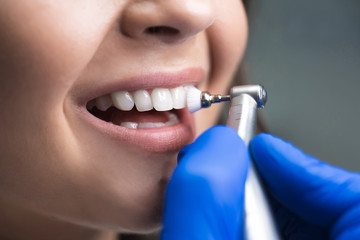
Gums Procedure

-
Scaling and root planing: This is a deep cleaning procedure that removes tartar and bacteria from the teeth and roots. It is often used to treat gum disease.
-
Gum graft surgery: This procedure involves taking gum tissue from one part of the mouth and using it to cover exposed roots or to add volume to thinning gums.
-
Periodontal flap surgery: This procedure involves making small incisions in the gum tissue to expose the roots of the teeth and remove tartar and bacteria. The gum tissue is then sutured back into place.
-
Gum abscess drainage: If a patient has a gum abscess (a pocket of pus caused by a bacterial infection), a dental professional may need to drain the abscess and clean the affected area.
-
Gingivectomy: This procedure involves removing excess gum tissue to improve the appearance of the gums or to make it easier to keep the teeth clean.
It is important to consult with a dental professional to determine which procedure is most appropriate for your specific needs.
What Is Gums Procedure:
A gum procedure is a type of dental treatment that is used to address issues with the gums, such as gum disease, gum recession, or excess gum tissue. There are several different types of gum procedures that a dental professional may perform, depending on the specific needs of the patient. Some common gum procedures include:
-
Scaling and root planing: This is a deep cleaning procedure that removes tartar and bacteria from the teeth and roots. It is often used to treat gum disease.
-
Gum graft surgery: This procedure involves taking gum tissue from one part of the mouth and using it to cover exposed roots or to add volume to thinning gums.
-
Periodontal flap surgery: This procedure involves making small incisions in the gum tissue to expose the roots of the teeth and remove tartar and bacteria. The gum tissue is then sutured back into place.
-
Gum abscess drainage: If a patient has a gum abscess (a pocket of pus caused by a bacterial infection), a dental professional may need to drain the abscess and clean the affected area.
It is important to consult with a dental professional to determine which procedure is most appropriate for your specific needs.
what We Should Know About The Gums Procedure:
Here are some things you should know about gum procedures:
-
Gum procedures are usually performed by a periodontist or a dentist with specialized training in gum treatment.
-
Gum procedures may be necessary to treat gum disease, which is an infection of the gums that can lead to tooth loss if left untreated. Gum disease is caused by a buildup of plaque and tartar on the teeth and can be prevented through proper oral hygiene and regular dental checkups.
-
Gum procedures may be done to correct gum recession, which is when the gum tissue pulls away from the teeth, exposing the roots. This can cause sensitivity and make the teeth more prone to decay.
-
Gum procedures may be used to improve the appearance of the gums or to make it easier to keep the teeth clean. For example, a gingivectomy may be performed to remove excess gum tissue.
-
Gum procedures are typically done under local anesthesia, which numbs the area being treated. Some procedures may require sedation to help the patient relax.
-
After a gum procedure, the patient may experience some pain, swelling, and bleeding. The dental professional will provide instructions for post-procedure care, which may include taking medications, using ice packs, and avoiding certain foods.
-
The success of a gum procedure depends on the patient's oral hygiene habits and ability to follow the dental professional's instructions. It is important to practice good oral hygiene and attend regular checkups to ensure that the gums remain healthy.
Gums Procedure How To Get It?
If you think you may need a gum procedure, the first step is to schedule an appointment with a dental professional, such as a dentist or a periodontist. During the appointment, the dental professional will examine your mouth and discuss your medical and dental history with you. They may also take X-rays or perform other diagnostic tests to determine the condition of your gums and teeth.
Based on the results of the examination and diagnostic tests, the dental professional will recommend a treatment plan, which may include a gum procedure. They will explain the details of the procedure and answer any questions you may have.
If you decide to proceed with the procedure, the dental professional will schedule a date and time for the procedure. They will also provide instructions on how to prepare for the procedure, such as whether you should eat or drink anything beforehand and what medications you should take or avoid.
It is important to follow the instructions provided by the dental professional and to arrive on time for the appointment. If you have any questions or concerns, be sure to discuss them with the dental professional before the procedure.
Gums Procedure How Its Work?
The specific details of a gum procedure will depend on the type of procedure being performed and the specific needs of the patient. Here is a general overview of how some common gum procedures may be performed:
-
Scaling and root planing: During this procedure, the dental professional will use special tools to remove plaque and tartar from the teeth and roots. They may also smooth the roots to make it more difficult for bacteria to adhere to them. This procedure is usually done in multiple visits and may require local anesthesia.
-
Gum graft surgery: During this procedure, the dental professional will take gum tissue from another part of the mouth (such as the roof of the mouth) and use it to cover exposed roots or to add volume to thinning gums. The tissue may be stitched into place using dissolvable sutures. This procedure is usually done under local anesthesia or conscious sedation.
-
Periodontal flap surgery: During this procedure, the dental professional will make small incisions in the gum tissue to expose the roots of the teeth. They will then remove tartar and bacteria from the roots and smooth the roots to make it more difficult for bacteria to adhere to them. The gum tissue is then sutured back into place. This procedure is usually done under local anesthesia or conscious sedation.
-
Gum abscess drainage: If a patient has a gum abscess, the dental professional will make a small incision in the gum to drain the abscess. They may also clean the affected area and prescribe antibiotics to help clear the infection. This procedure is usually done under local anesthesia.
-
Gingivectomy: During this procedure, the dental professional will remove excess gum tissue using a scalpel or laser. The procedure is usually done under local anesthesia or conscious sedation.
It is important to follow the instructions provided by the dental professional before and after the procedure to ensure the best possible outcome.

Gums Procedure Conclusion:
Gum procedures are a type of dental treatment used to address issues with the gums, such as gum disease, gum recession, or excess gum tissue. There are several different types of gum procedures, including scaling and root planing, gum graft surgery, periodontal flap surgery, gum abscess drainage, and gingivectomy. These procedures may be performed by a dentist or a periodontist and may be done under local anesthesia or conscious sedation.
The success of a gum procedure depends on the patient's oral hygiene habits and ability to follow the dental professional's instructions. It is important to practice good oral hygiene and attend regular checkups to ensure that the gums remain healthy. If you think you may need a gum procedure, it is important to schedule an appointment with a dental professional for a proper evaluation and treatment plan.
SIIT Courses and Certification
Also Online IT Certification Courses & Online Technical Certificate Programs

